电子科技大学:《语言学通论 General Linguistics》课程教学资源(课件讲稿)09 Pragmatics(Utterance Meaning)

Pragmatics Utterance Meaning 楚军外国语学院
Utterance Meaning 楚军 外国语学院 Pragmatics
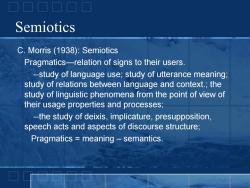
Semiotics C.Morris (1938):Semiotics Pragmatics-relation of signs to their users. --study of language use;study of utterance meaning; study of relations between language and context.;the study of linguistic phenomena from the point of view of their usage properties and processes; --the study of deixis,implicature,presupposition, speech acts and aspects of discourse structure; Pragmatics meaning-semantics
Semiotics C. Morris (1938): Semiotics Pragmatics—relation of signs to their users. --study of language use; study of utterance meaning; study of relations between language and context.; the study of linguistic phenomena from the point of view of their usage properties and processes; --the study of deixis, implicature, presupposition, speech acts and aspects of discourse structure; Pragmatics = meaning – semantics
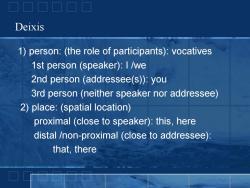
Deixis 1)person:(the role of participants):vocatives 1st person (speaker):I /we 2nd person (addressee(s)):you 3rd person (neither speaker nor addressee) 2)place:(spatial location) proximal (close to speaker):this,here distal /non-proximal (close to addressee): that,there
Deixis 1) person: (the role of participants): vocatives 1st person (speaker): I /we 2nd person (addressee(s)): you 3rd person (neither speaker nor addressee) 2) place: (spatial location) proximal (close to speaker): this, here distal /non-proximal (close to addressee): that, there
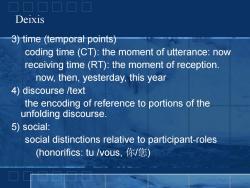
Deixis 3)time (temporal points) coding time (CT):the moment of utterance:now receiving time(RT):the moment of reception. now,then,yesterday,this year 4)discourse /text the encoding of reference to portions of the unfolding discourse. 5)social: social distinctions relative to participant-roles (honorifics:tu /vous,你/您)
Deixis 3) time (temporal points) coding time (CT): the moment of utterance: now receiving time (RT): the moment of reception. now, then, yesterday, this year 4) discourse /text the encoding of reference to portions of the unfolding discourse. 5) social: social distinctions relative to participant-roles (honorifics: tu /vous, 你/您)
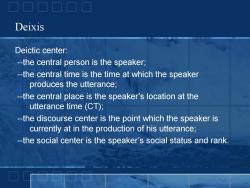
Deixis Deictic center: --the central person is the speaker; --the central time is the time at which the speaker produces the utterance; --the central place is the speaker's location at the utterance time (CT); --the discourse center is the point which the speaker is currently at in the production of his utterance; --the social center is the speaker's social status and rank
Deixis Deictic center: --the central person is the speaker; --the central time is the time at which the speaker produces the utterance; --the central place is the speaker’s location at the utterance time (CT); --the discourse center is the point which the speaker is currently at in the production of his utterance; --the social center is the speaker’s social status and rank
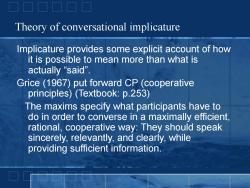
Theory of conversational implicature Implicature provides some explicit account of how it is possible to mean more than what is actually“said". Grice(1967)put forward CP (cooperative principles)(Textbook:p.253) The maxims specify what participants have to do in order to converse in a maximally efficient rational,cooperative way:They should speak sincerely,relevantly,and clearly,while providing sufficient information
Theory of conversational implicature Implicature provides some explicit account of how it is possible to mean more than what is actually “said”. Grice (1967) put forward CP (cooperative principles) (Textbook: p.253) The maxims specify what participants have to do in order to converse in a maximally efficient, rational, cooperative way: They should speak sincerely, relevantly, and clearly, while providing sufficient information
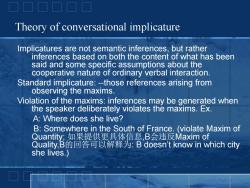
Theory of conversational implicature Implicatures are not semantic inferences,but rather inferences based on both the content of what has been said and some specific assumptions about the cooperative nature of ordinary verbal interaction. Standard implicature:--those references arising from observing the maxims. Violation of the maxims:inferences may be generated when the speaker deliberately violates the maxims.Ex. A:Where does she live? B:Somewhere in the South of France.(violate Maxim of Quantity;如果提供更具体信息,B会违反Maxim of Quality,B的回答可以解释为:B doesn't know in which city she lives.)
Theory of conversational implicature Implicatures are not semantic inferences, but rather inferences based on both the content of what has been said and some specific assumptions about the cooperative nature of ordinary verbal interaction. Standard implicature: --those references arising from observing the maxims. Violation of the maxims: inferences may be generated when the speaker deliberately violates the maxims. Ex. A: Where does she live? B: Somewhere in the South of France. (violate Maxim of Quantity; 如果提供更具体信息,B会违反Maxim of Quality,B的回答可以解释为: B doesn’t know in which city she lives.)
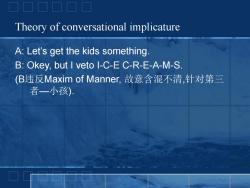
Theory of conversational implicature A:Let's get the kids something. B:Okey,but I veto I-C-E C-R-E-A-M-S. (B违反Maxim of Manner,.故意含混不清,针对第三 者一小孩)
Theory of conversational implicature A: Let’s get the kids something. B: Okey, but I veto I-C-E C-R-E-A-M-S. (B违反Maxim of Manner, 故意含混不清,针对第三 者—小孩)
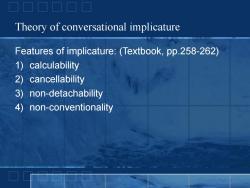
Theory of conversational implicature Features of implicature:(Textbook,pp.258-262) 1)calculability 2)cancellability 3)non-detachability 4) non-conventionality
Theory of conversational implicature Features of implicature: (Textbook, pp.258-262) 1) calculability 2) cancellability 3) non-detachability 4) non-conventionality
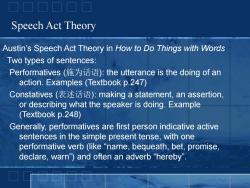
Speech Act Theory Austin's Speech Act Theory in How to Do Things with Words Two types of sentences: Performatives(施为话语):the utterance is the doing of an action.Examples (Textbook p.247) Constatives(表述话语):making a statement,an assertion, or describing what the speaker is doing.Example (Textbook p.248) Generally,performatives are first person indicative active sentences in the simple present tense,with one performative verb (like "name,bequeath,bet,promise, declare,warn")and often an adverb“hereby
Speech Act Theory Austin’s Speech Act Theory in How to Do Things with Words Two types of sentences: Performatives (施为话语): the utterance is the doing of an action. Examples (Textbook p.247) Constatives (表述话语): making a statement, an assertion, or describing what the speaker is doing. Example (Textbook p.248) Generally, performatives are first person indicative active sentences in the simple present tense, with one performative verb (like “name, bequeath, bet, promise, declare, warn”) and often an adverb “hereby
按次数下载不扣除下载券;
注册用户24小时内重复下载只扣除一次;
顺序:VIP每日次数-->可用次数-->下载券;
- 电子科技大学:《语言学通论 General Linguistics》课程教学资源(课件讲稿)10 Langugae, culture & society.pdf
- 电子科技大学:《语言学通论 General Linguistics》课程教学资源(课件讲稿)语义学——Sentence meaning(Predication Analysis).pdf
- 电子科技大学:《语言学通论 General Linguistics》课程教学资源(课件讲稿)语义学——Componential Analysis.pdf
- 电子科技大学:《语言学通论 General Linguistics》课程教学资源(课件讲稿)语义学——Context, changes in word meaning, figures of speech.pdf
- 电子科技大学:《语言学通论 General Linguistics》课程教学资源(课件讲稿)语义学——Semantics(Sense Relations).pdf
- 电子科技大学:《语言学通论 General Linguistics》课程教学资源(课件讲稿)语义学——Types of word-meaning.pdf
- 电子科技大学:《语言学通论 General Linguistics》课程教学资源(课件讲稿)07 Semantics(Introduction).pdf
- 电子科技大学:《语言学通论 General Linguistics》课程教学资源(课件讲稿)06 Functional Grammar.pdf
- 电子科技大学:《语言学通论 General Linguistics》课程教学资源(课件讲稿)05 句法 Syntax.pdf
- 电子科技大学:《语言学通论 General Linguistics》课程教学资源(课件讲稿)04 Formalist Approach.pdf
- 电子科技大学:《语言学通论 General Linguistics》课程教学资源(课件讲稿)03 Formalist Approach.pdf
- 电子科技大学:《语言学通论 General Linguistics》课程教学资源(课件讲稿)02 句法 Syntax.pdf
- 电子科技大学:《语言学通论 General Linguistics》课程教学资源(课件讲稿)01 Introduction(主讲:楚军).pdf
- 山东省“成人教育特色课程”项目配套教材:《大学语文》课程教材电子版(主编:戴永新).pdf
- 聊城大学:《大学语文》课程教学资源(阅读文献)中国现当代文学经典作品选.pdf
- 聊城大学:《大学语文》课程教学资源(阅读文献)外国文学经典作品选.pdf
- 聊城大学:《大学语文》课程教学资源(阅读文献)中国古代文学经典作品选.pdf
- 聊城大学:《大学语文》课程教学资源(电子教案讲义,共十五讲).docx
- 运城学院:《文学概论 literature theory》课程教学资源(电子教案,打印版,2/2,共两编八章).pdf
- 运城学院:《文学概论 literature theory》课程教学资源(电子教案,打印版,1/2,共三篇八章).pdf
- 电子科技大学:《语言学通论 General Linguistics》课程教学资源(课件讲稿)形态学 Morphology.pdf
- 电子科技大学:《语言学通论 General Linguistics》课程教学资源(课件讲稿)认知语言学中的相关话题 Cognitive Linguistics.pdf
- 弟子规(全文).pdf
- 《中国语言文化 Chinese Language and Culture》课程教学资源(书籍阅读材料)《中国古典哲学名著选读》郭齐勇.pdf
- 《中国语言文化 Chinese Language and Culture》课程教学资源(书籍阅读材料)《唐诗三百首》中英文对照(许渊冲)300 Tang Poems(Classified by Theme).pdf
- 《中国语言文化 Chinese Language and Culture》课程教学资源(书籍阅读材料)《二十四诗品校注译评》祖保泉.pdf
- 《中国语言文化 Chinese Language and Culture》课程教学资源(书籍阅读材料)《近代中国之种族观念》刘东.pdf
- 《中国语言文化 Chinese Language and Culture》课程教学资源(书籍阅读材料)《中国现代女作家与中国革命1905-1948》颜海平.pdf
- 《中国语言文化 Chinese Language and Culture》课程教学资源(书籍阅读材料)《世界秩序与文明等级》全球史研究的新路径(主编:刘禾).pdf
- 《中国语言文化 Chinese Language and Culture》课程教学资源(书籍阅读材料)《叫魂》SOULSTEALERS - The Chinese Sorcery Scare of 1768〔美〕孔飞力(1768年中国妖术大恐慌).pdf
- 电子科技大学:《中国语言文化 Chinese Language and Culture》课程教学资源(课件讲稿)导论(聂韬).pdf
- 电子科技大学:《中国语言文化 Chinese Language and Culture》课程教学资源(课件讲稿)第一讲 周易.pdf
- 电子科技大学:《中国语言文化 Chinese Language and Culture》课程教学资源(课件讲稿)第七讲 谶纬之学.pdf
- 电子科技大学:《中国语言文化 Chinese Language and Culture》课程教学资源(课件讲稿)第三讲 山海经.pdf
- 电子科技大学:《中国语言文化 Chinese Language and Culture》课程教学资源(课件讲稿)第二讲 尚书.pdf
- 电子科技大学:《中国语言文化 Chinese Language and Culture》课程教学资源(课件讲稿)第五讲 道家与魏晋风度.pdf
- 电子科技大学:《中国语言文化 Chinese Language and Culture》课程教学资源(课件讲稿)第八讲 诗歌的创作翻译与批评之平仄格律.pdf
- 电子科技大学:《中国语言文化 Chinese Language and Culture》课程教学资源(课件讲稿)第六讲 汉赋(中国古代辞赋).pdf
- 电子科技大学:《中国语言文化 Chinese Language and Culture》课程教学资源(课件讲稿)第九讲 中国与性别文学(古代女性创作的基本内容).pdf
- 电子科技大学:《中国语言文化 Chinese Language and Culture》课程教学资源(课件讲稿)第十讲 诗歌鉴赏(诗词曲的趣味之品诗之大成《二十四诗品》).pdf
